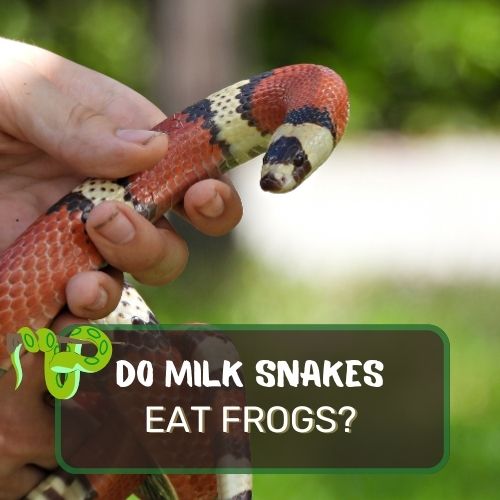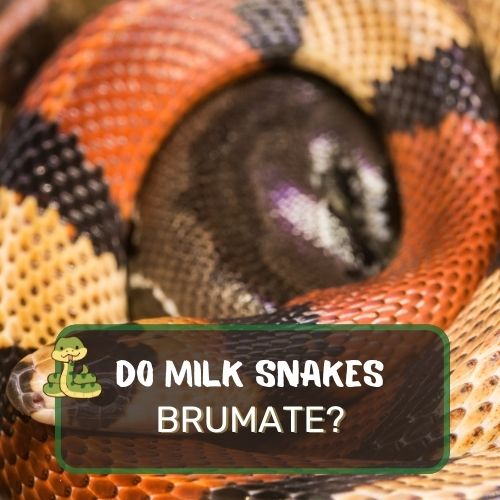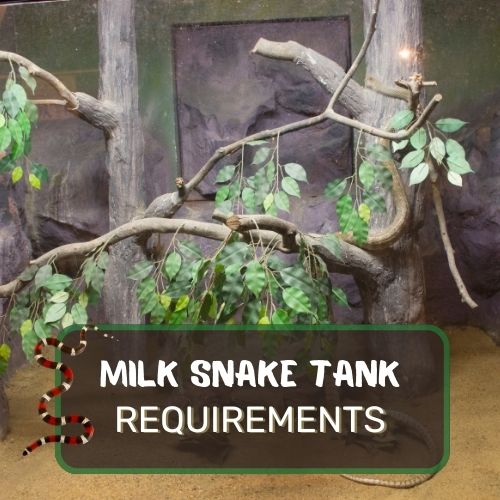Milk snakes, with their vivid colors and docile nature, have slithered into the hearts of reptile enthusiasts worldwide. But the pressing question still looms on whether milk snakes can eat crickets.
Absolutely! While milk snakes primarily prefer rodents like mice, they can eat crickets. Crickets offer protein and can be an occasional treat. However, always ensure they’re properly prepared, free from pesticides, and introduced gradually to monitor any potential reactions in the snake.
Before you serve up an insect treat, it’s crucial to understand their natural diet, the pros and cons of cricket munching, and other dietary options.
In this deep dive, we’ll explore everything from the mice they adore to the worms they might wiggle after, and yes, those chirping crickets. Let’s unravel the dietary mysteries of these magnificent reptiles!

Table of Contents
The Main Course: Natural Prey of Milk Snakes
When it comes to gourmet dining in the world of reptiles, milk snakes certainly have their own unique palate. If you’re a newbie snake owner or just genuinely curious, let’s break down what these stunning creatures typically munch on.
The Types of Rodents They Consume
Milk snakes, like many of their slithering counterparts, have a strong affinity for rodents. Mice? Absolutely.
Baby rats? They’re on the menu too.
But why rodents, you ask? Well, rodents serve as an excellent source of protein and are usually the right size for milk snakes to handle. It’s kind of like how some of us prefer a juicy steak or a hearty burger—milk snakes see rodents as their prime cut of meat.
In captivity, it’s common for owners to feed their milk snakes frozen-thawed rodents. This method is both safe for the snake (no risk of being bitten or injured by live prey) and convenient for the owner.
Plus, the frozen-thawed variety is available in various sizes, ensuring that the snake gets a meal suitable for its size.
Preference for Birds and Bird Eggs
Now, here’s where it gets intriguing. Milk snakes have been known to raid nests and gulp down bird eggs. It’s a bit like their version of a breakfast omelet.
These eggs are packed with nutrients, and for a milk snake, it’s a relatively easy meal to find and consume—no chasing or constricting required.
It’s worth noting, however, that while they do have a taste for bird eggs, it’s not their primary food source. So, if you’re envisioning your milk snake sneaking out at night, scaling trees to raid nests, that’s probably more of a rare adventure than a nightly routine.
But it’s a testament to their adaptability and varied diet.
Occasional Ingestion of Amphibians
Now, for the wildcard in the milk snake’s diet—amphibians! Frogs and salamanders, to be specific. In the wild, especially in areas where rodents or birds might be scarce, milk snakes diversify their diet with these slippery creatures.
Think of it as them experimenting with international cuisine.
The occasional frog or salamander offers a different set of nutrients and is an example of how versatile these snakes can be when it comes to their diet.
However, if you’re considering adding amphibians to your pet milk snake’s menu, it’s always a good idea to consult with a herpetologist or vet first. Just like us trying out a new dish at a restaurant, it’s essential to ensure it’s safe and beneficial for them.
Now that we’ve had a little culinary journey through the milk snake’s diet, the big question remains: can a milk snake eat crickets? But that’s a topic for another section.
For now, let’s appreciate the varied and fascinating menu of the milk snake, a creature that’s as adaptable in its diet as it is beautiful in appearance.

Pros of Feeding Crickets to Milk Snakes
When considering what to feed your milk snake, crickets might not be the first item that springs to mind. But hey, let’s think outside the terrarium! Crickets have several advantages as a potential food source for these fascinating reptiles.
Nutritional Value of Crickets
Firstly, let’s chat about the nutritional bonanza that is the cricket. These little jumpers are protein powerhouses, providing essential amino acids. Additionally, crickets are a good source of vitamins, minerals, and healthy fats.
They’re like the superfood smoothie of the insect world. For milk snakes, this means a potential supplement to their usual diet that can provide essential nutrients, especially if you’re ensuring they’re gut-loaded before serving.
Availability and Cost-Effectiveness
Crickets are also readily available in many pet stores. You won’t have to embark on a wild goose chase (or should we say cricket chase?) to find them. Plus, they’re often sold in bulk at a relatively low cost.
This means your snake can dine on a budget without compromising the quality of its meal.
Crickets’ Life Cycle and Breeding Benefits
Crickets have a rapid life cycle, which can be beneficial if you’re considering breeding them yourself. This ensures a constant and fresh supply of food for your milk snake.
Plus, breeding crickets can be an engaging hobby, giving you full control over their diet and ensuring they’re free from harmful substances.

Cons of Feeding Crickets to Milk Snakes
As with most things in life, there’s always the other side of the coin. While crickets have their perks, there are also potential drawbacks when considering them as a primary food source for milk snakes.
Potential Health Risks
Crickets, especially if sourced from unreliable places, might carry parasites or be exposed to pesticides. This can be detrimental to a snake’s health if they ingest contaminated crickets. It’s like us eating spoiled food—it’s just not a good idea.
Digestive Concerns
Milk snakes, by nature, have evolved to consume rodents, birds, and occasionally amphibians. Their digestive systems are designed to process these types of prey.
Introducing crickets into their diet might lead to digestive issues if not done correctly or if done excessively. It’s essential to monitor how your snake reacts after consuming crickets.
Behavioral Changes in Snakes
Changing a snake’s diet can sometimes lead to alterations in its behavior. They might become more aggressive, less active, or show signs of stress. It’s like when we switch from coffee to decaf—we’re just not the same!
While crickets can offer a new dining experience for milk snakes, it’s crucial to weigh the pros and cons. Always ensure you’re making the best decision for your slithery friend’s health and happiness.

Alternative Foods for Milk Snakes
Milk snakes aren’t picky eaters, but they do have some favorites. While we’ve already covered their interest in crickets, it’s essential to highlight other foods that might appeal to their reptilian palate.
Mice and Their Benefits
Mice are the staple food for many snakes, and milk snakes are no exception. Rich in protein, they provide all the essential nutrients a snake needs. Whether it’s pinkies (baby mice) for younger snakes or adult mice for mature ones, they’re an excellent choice.
Plus, the act of constricting their prey is a natural behavior that can be beneficial for a snake’s physical and mental well-being.
Other Insects and Invertebrates
Beyond crickets, milk snakes might show interest in other invertebrates. Earthworms, for example, can be a tasty treat. It’s like their version of spaghetti!
Other insects like mealworms can also be considered, but always ensure any insect you introduce is safe and free from contaminants.
Vitamins and Supplements to Consider
Like all pets, milk snakes can benefit from added vitamins and supplements. Calcium powders or vitamin D3 supplements can ensure they’re getting everything they need, especially if their primary diet is not rodent-based.

How to Safely Introduce Crickets to a Milk Snake’s Diet
Considering giving your milk snake a cricket treat? Here’s a step-by-step guide to ensure the introduction goes smoothly.
Preparing the Crickets
Before serving, ensure the crickets are gut-loaded. This means they’ve been fed nutritious food before becoming food themselves. This enhances their nutritional value for the snake. It’s like marinating a steak before grilling it!
Observing the Snake’s Behavior
Once you’ve introduced the cricket, watch your milk snake closely. Is it showing interest? Is it avoiding the cricket? Observing its behavior can give you insights into whether crickets might be a regular feature on the menu or just an occasional treat.
Monitoring Health and Well-being Post Feeding
After the meal, keep an eye on your snake. Look for signs of discomfort or changes in behavior. Remember, introducing a new food can sometimes be a bit of a shock to their system.
Like when we try a new dish at a restaurant, there’s always that moment of wondering how our stomach will react!
Conclusion
You’ve journeyed through the fascinating world of milk snake diets, uncovering their preference for rodents, occasional treats like crickets, and even surprising prey like other snakes.
It’s clear that understanding your milk snake’s dietary needs is vital for its health and well-being. Remember, always introduce new foods gradually and monitor their reaction.
Your dedication to learning and ensuring your snake’s well-being truly sets you apart. Here’s to many more exciting discoveries with your scaly friend. Keep up the fantastic work!
FAQ
Let’s dive into some of the most commonly asked questions and shed some light (or scales) on these queries.
What Can I Feed My Milk Snake?
Milk snakes have a diverse diet, but rodents, particularly mice, are their top pick. They can also occasionally consume birds, bird eggs, and amphibians. Some owners even introduce insects like crickets or worms, but always ensure any new food is introduced safely.
Do Milk Snakes Eat Rattlesnakes?
It’s a wild fact, but yes! Some milk snakes have been known to prey on other snakes, including venomous ones like rattlesnakes. Nature can be pretty wild, right? However, this behavior is more common in the wild and is not something you’d typically see in captivity.
Do Milk Snakes Eat Worms?
Indeed, they can! Earthworms can serve as a treat for milk snakes, especially for younger ones. They’re like the gummy worms of the reptile world. However, always ensure any worms you provide are clean and free from pesticides or other harmful substances.




0 Comments